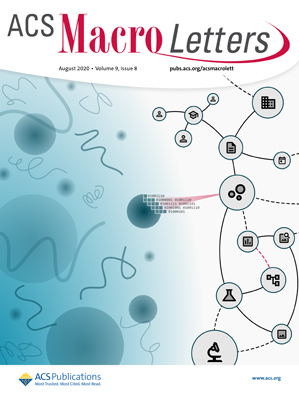Gel–Gel Phase Separation in Clustered Poly(ethylene glycol) Hydrogel with Enhanced Hydrophobicity
IF 5.2
Q1 POLYMER SCIENCE
引用次数: 0
Abstract
The development of hydrophobic poly(ethylene glycol) (PEG) hydrogels, which are typically hydrophilic, could significantly enhance their application as artificial extracellular matrices. In this study, we designed PEG hydrogels with enhanced hydrophobicity through gel–gel phase separation (GGPS), a phenomenon that uniquely enhances hydrophobicity under ambient conditions, and we elucidated the pivotal role of elasticity in this process. We hypothesized that increased elasticity would amplify GGPS, thereby improving the hydrophobicity and cell adhesion on PEG hydrogel surfaces, despite their inherent hydrophilicity. To test this hypothesis, we engineered dilute oligo-PEG gels via a two-step process, creating polymer networks from tetra-PEG clusters with multiple reaction points. These oligo-PEG gels exhibited significantly higher elasticity, turbidity, and shrinkage upon water immersion compared to dilute PEG gels. Detailed characterization through confocal laser scanning microscopy, rheological measurements, and cell adhesion assays revealed distinct biphasic structures, increased hydrophobicity, and enhanced cell attachability in the dilute oligo-PEG gels. Our findings confirm that elasticity is crucial for effective GGPS, providing a novel method for tailoring hydrogel properties without chemical modification. This research introduces a new paradigm for designing biomaterials with improved cell-scaffolding capabilities, offering significant potential for tissue engineering and regenerative medicine.具有增强疏水性的成簇聚乙二醇水凝胶中的凝胶-凝胶相分离技术
疏水性聚乙二醇(PEG)水凝胶通常具有亲水性,开发疏水性聚乙二醇(PEG)水凝胶可大大提高其作为人工细胞外基质的应用。在这项研究中,我们设计了通过凝胶-凝胶相分离(GGPS)增强疏水性的 PEG 水凝胶,这种现象在环境条件下能独特地增强疏水性,我们还阐明了弹性在这一过程中的关键作用。我们假设弹性的增加会放大 GGPS,从而改善 PEG 水凝胶表面的疏水性和细胞粘附性,尽管它们本身具有亲水性。为了验证这一假设,我们通过两步法设计出了稀释的低聚 PEG 凝胶,从具有多个反应点的四聚 PEG 团簇中生成了聚合物网络。与稀释 PEG 凝胶相比,这些低聚 PEG 凝胶在浸水后的弹性、浑浊度和收缩率都明显更高。通过共焦激光扫描显微镜、流变学测量和细胞粘附试验进行的详细表征显示,稀释的低聚聚乙二醇凝胶具有独特的双相结构、疏水性增加以及细胞粘附性增强。我们的研究结果证实,弹性对于有效的 GGPS 至关重要,这提供了一种无需化学修饰即可定制水凝胶特性的新方法。这项研究为设计具有更强细胞支架能力的生物材料引入了一种新的范式,为组织工程和再生医学提供了巨大的潜力。
本文章由计算机程序翻译,如有差异,请以英文原文为准。
求助全文
约1分钟内获得全文
求助全文
来源期刊
CiteScore
10.40
自引率
3.40%
发文量
209
审稿时长
1 months
期刊介绍:
ACS Macro Letters publishes research in all areas of contemporary soft matter science in which macromolecules play a key role, including nanotechnology, self-assembly, supramolecular chemistry, biomaterials, energy generation and storage, and renewable/sustainable materials. Submissions to ACS Macro Letters should justify clearly the rapid disclosure of the key elements of the study. The scope of the journal includes high-impact research of broad interest in all areas of polymer science and engineering, including cross-disciplinary research that interfaces with polymer science.
With the launch of ACS Macro Letters, all Communications that were formerly published in Macromolecules and Biomacromolecules will be published as Letters in ACS Macro Letters.

 求助内容:
求助内容: 应助结果提醒方式:
应助结果提醒方式:


